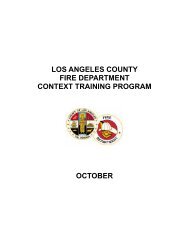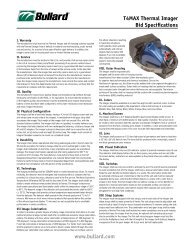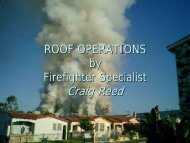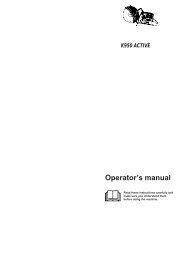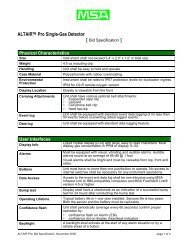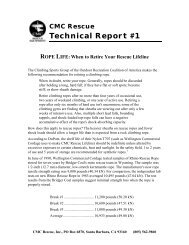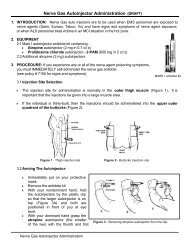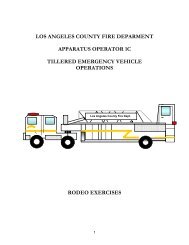Truck Company Operations Guide- Salvage.pdf
Truck Company Operations Guide- Salvage.pdf
Truck Company Operations Guide- Salvage.pdf
Create successful ePaper yourself
Turn your PDF publications into a flip-book with our unique Google optimized e-Paper software.
Subject 8<br />
SALVAGE<br />
Definition and<br />
Basic Objectives<br />
<strong>Salvage</strong> is the<br />
protection of<br />
buildings and their<br />
contents from unnecessary damage due to water,<br />
smoke, heat , and other elements. It is estimated that seventy-five percent (75%) of total<br />
fire loss is created during extinguishing operations and other events occurring after the fire,<br />
(Indirect damage). Twenty-five percent (25%) represents the loss actually caused by the fire,<br />
(Direct damage). Although we can do little to prevent direct loss caused by fire and its byproducts,<br />
speedy and efficient salvage operations, performed as early as time and personnel<br />
permit, can greatly reduce the total loss and inconvenience to a structure and its occupants.
82<br />
<strong>Truck</strong> <strong>Company</strong> <strong>Operations</strong> <strong>Guide</strong>lines and Considerations<br />
Forcible Entry<br />
Ventilation<br />
Use of Hose Streams<br />
Overhaul<br />
By nature, some suppression tasks result in damage to a structure, e.g., forcible entry, ventilation,<br />
use of hose streams, etc. The fire departments obligation rests with every crew member, from forcible<br />
entry to the final stages of overhaul, with regard to controlling damage in order to keep losses to a<br />
minimum.<br />
The success or failure of salvage operations can be directly attributed to the degree to which those<br />
involved have familiarized themselves with salvage equipment and techniques. It is a combination of<br />
this familiarity mixed with a good dose of imagination and ingenuity that will enable effective and<br />
timely salvage at the scene of an emergency.<br />
REMEMBER: <strong>Salvage</strong> remains an essential function of the fire service. Victims of fire and other<br />
disasters recognize and appreciate the fire department’s efforts when irreplaceable personal belongings<br />
and other contents of a home or business are saved through efficient salvage work. <strong>Salvage</strong> does not<br />
require a huge workforce. It can be performed by a small number of well trained, well-prepared<br />
personnel. In simple terms,<br />
EFFECTIVE SALVAGE = GOOD PUBLIC RELATIONS
<strong>Salvage</strong><br />
83<br />
Strategic Priorities<br />
Strategic priorities, relating to salvage<br />
operations, will be dictated by the type of<br />
incident (fire, flood, etc.). Other factors to be<br />
considered may include, but are not limited to:<br />
— Type and size of structure<br />
— Type of construction<br />
— Occupancy<br />
Residential – Start with irreplaceable<br />
personal belongings such as family<br />
photographs and other items of possible<br />
sentimental value. Then move on to<br />
clothing and other essentials, and finally,<br />
consider televisions, furniture, etc.<br />
Commercial – Give priority to any<br />
bookkeeping materials and other records<br />
including computers, then move on to<br />
merchandise.<br />
Industrial – As with commercial,<br />
consider records first. Then pay attention<br />
to any valuable machinery and raw<br />
materials.<br />
— Progression of incident at time of arrival<br />
— Value of contents<br />
— Automatic fire protection systems<br />
— Possible location of records and files<br />
(including computers)<br />
— Personnel available<br />
— <strong>Salvage</strong> equipment available<br />
An effective salvage operation begins with a<br />
good size-up as part of a coordinated attack.<br />
Size-up of an incident must be made to gather<br />
data for decisions on what needs to be done and<br />
how to best perform those tasks. <strong>Salvage</strong> sizeup<br />
should begin upon receipt of the alarm and<br />
must be included in all phases of fireground<br />
operations. The same system of size-up used for<br />
a fire can easily be adapted to other salvage type<br />
incidents. It includes the following steps:<br />
— Facts - Nature of incident, type of<br />
occupancy, type of construction.<br />
— Probabilities - Estimation of progress,<br />
possible hazards, weather.<br />
— Available Resources - Type and quantity<br />
necessary to perform effectively.<br />
— Decision - What are the objectives?<br />
— Plan of Operation - How to accomplish<br />
objectives.<br />
Tactical<br />
Considerations<br />
Controlled damage at the scene of an incident<br />
is the goal of salvage. To achieve this goal crew<br />
members should train and become proficient in<br />
all operations relating to the following:<br />
9-3<br />
Forcible Entry – Know how to gain access<br />
with a limited amount of damage. Make sure<br />
the amount of damage is warranted and<br />
necessary in relation to the urgency of the<br />
situation. In other words, if there is no<br />
immediate life hazard and no significant sign of<br />
fire, consider a less destructive means of entry<br />
than breaking down a door or taking out a<br />
window.
84<br />
<strong>Truck</strong> <strong>Company</strong> <strong>Operations</strong> <strong>Guide</strong>lines and Considerations<br />
ALWAYS CONSIDER:<br />
Urgency vs.<br />
Amount of Damage<br />
Ventilation – To minimize damage from fire,<br />
smoke and heat should be confined to as small<br />
an area as possible. Ordinary doors are<br />
extremely effective in blocking smoke and<br />
convected heat. If no door exists, plastic or<br />
salvage covers work extremely well as a<br />
temporary draft curtain in this situation. Rapid<br />
removal of heat and other products of<br />
combustion can significantly lower the amount<br />
of direct fire loss. First consider horizontal<br />
ventilation, e.g., positive pressure ventilation<br />
utilizing natural or existing openings. If<br />
horizontal ventilation is insufficient and vertical<br />
ventilation is deemed necessary, be sure to make<br />
a hole only large enough to do the job. If<br />
horizontal ventilation worked well enough, leave<br />
well enough alone and don’t cut holes in roofs for<br />
the sake of a drill. Consider covering the hole<br />
or other openings with plastic before leaving the<br />
scene.<br />
Application of Water – Although it is not<br />
thought of a a normal <strong>Truck</strong> <strong>Company</strong><br />
function, it needs to be said that applying water<br />
at the wrong time, from the wrong place, with<br />
the wrong nozzle pattern causes a significant<br />
amount of preventable damage. Make every<br />
attempt to locate the seat of the fire and use only<br />
as mush water as is necessary to control the<br />
situation. Often the water extinguisher carried<br />
by truck companies can control a small fire even<br />
before hose lines are in place.<br />
Dewatering – Methods used to remove water<br />
from a structure are only limited by the amount<br />
of salvage equipment on hand and the<br />
imagination of the crew. Often, these<br />
operations should be started in unaffected<br />
portions of the structure that may be threatened<br />
by the progression of the incident. Do not<br />
waste time attempting to save already damaged<br />
goods when it can be better spent directing the<br />
flow of water or removing goods and materials<br />
from the path of water. In multiple story<br />
buildings salvage may need to be initiated on<br />
lower floors before the affected floor. Every<br />
attempt should be made to stop the source of<br />
the water while continuing to control the path<br />
of the water.<br />
Overhaul – Hap-Hazard overhaul techniques<br />
can also contribute to greater fire loss. An<br />
attentive overhaul crew can sometimes recover<br />
valuables that may have been written off as a<br />
total loss. Many a business has been able to<br />
reopen its doors because partially files were<br />
legible enough to allow restoration.<br />
Covering of Goods and Materials – In order<br />
to be effective, this operation must begin as<br />
SALVAGE<br />
COVER<br />
PLASTIC
<strong>Salvage</strong><br />
85<br />
early in the incident as possible. Before<br />
covering is begun consider these facts:<br />
— Can the valuables be moved to a safe<br />
location, eliminating the need for<br />
covering?<br />
— Is there enough covers or plastic to<br />
safely and effectively cover all the<br />
valuables?<br />
— Are the valuables you intend to cover<br />
already lost to fire, smoke or water?<br />
Although traditional salvage covers continue<br />
to prove invaluable in fire, heat or other<br />
specialty situations, plastic should be given<br />
strong consideration in the following situations:<br />
— As an additional vapor barrier under a<br />
salvage cover.<br />
— If the area to be covered is in excess of a<br />
standard 12 x 18 foot salvage cover.<br />
— Valuables will require covering for an<br />
extended period of time.<br />
If covers were used initially they can be<br />
replaced with plastic prior to leaving the<br />
scene.<br />
— If covering for water protection on<br />
floor(s) below an incident.<br />
— Limited manpower.<br />
Plastic is also advantage because large<br />
quantities can be easily stored on the apparatus,<br />
it can be left at the scene indefinitely, and it is<br />
extremely cost effective. ($10.00 per roll<br />
compared to $150.00 per salvage cover)<br />
=<br />
$150.00 $150.00<br />
Another advantage of plastic is the case with<br />
which it can be hung using only a staplegun.<br />
This makes it an excellent choice for “bagging”<br />
a room prior to pulling a ceiling during a<br />
creeping attic fire. Upon completion the plastic<br />
and staples can be removed, leaving only small<br />
staple holes in the walls and a relatively clean,<br />
dust free environment in the rest of the<br />
structure.<br />
Summary<br />
If 75 percent of fire loss is indirect, salvage,<br />
then, is a vary important fire department<br />
operation. <strong>Salvage</strong> should be a concern during<br />
every phase of the incident, from forcible entry<br />
to overhaul. Along with its other<br />
responsibilities, the fire department must<br />
attempt to limit suppression damage as much as<br />
possible. The result will be reduced fire loss,<br />
valuable possessions saved, and businesses able<br />
to reopen their doors.



